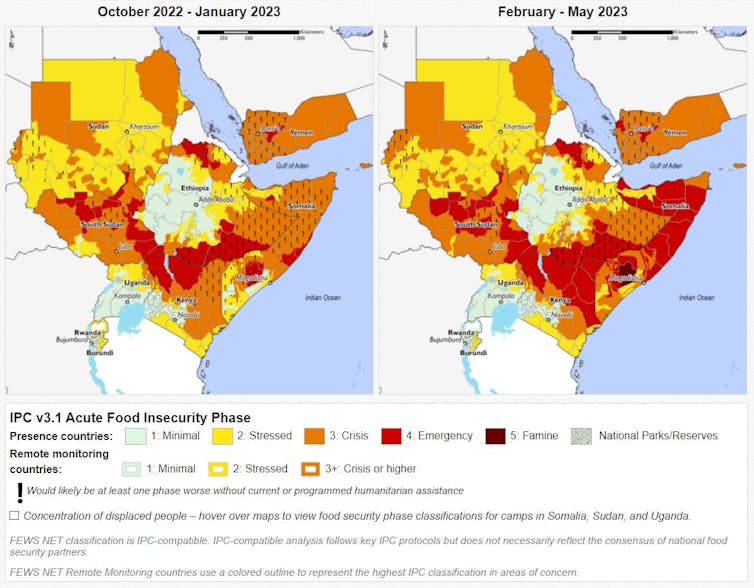
Gina Charnley, Imperial College London
Countries in the Horn of Africa have been hit by a multiyear drought. Ethiopia, Kenya, Somalia and Uganda are expected to continue getting below-normal rainfall in 2023. Excluding Uganda, 36.4 million people are affected and 21.7 million are in need of food assistance.
Climate change projections show changes in temperature and rainfall extremes, especially without emissions reductions. Some parts of Africa are projected to become wetter and others drier. Prolonged dry spells, particularly in semi-arid and arid regions, may have serious impacts, particularly if people aren’t prepared.

Droughts can have wide-ranging implications for the affected population. The decreased availability of water – often accompanied by high temperatures – can increase the risk of contamination, cause dehydration and result in an inability to wash and maintain hygiene practices.
Droughts can have an impact on non-resistant crops and livestock, causing malnutrition and food insecurity. The economic implications of agricultural losses can go on to affect mental health, gender-based violence and poverty.
The changes to the environment and human behaviour caused by drought can also lead to higher exposure to disease-causing organisms. It can increase the risk of infections and disease outbreaks. Diseases that are spread through food, water, insects and other animals can all break out during times of drought and often overlap. Understanding and managing the known risk factors for these outbreaks, and how drought can exacerbate them, is important in preventing infectious disease mortality during drought.
Food-borne diseases
During droughts there can be changes in what kinds of food are accessible, as less water is available to produce and process it. Food insecurity can lead to malnutrition, which has an impact on immunity. Certain foods may become less available and it may not be possible to reduce food contamination via traditional methods of acidification such as lemon juice, curdled milk, tamarind and vinegar.
Food insecurity can lead to an increased reliance on roadside food vendors. Food vendors are often linked to food-borne disease outbreaks as hygiene standards can vary widely and are often poorly regulated. Cooking fuel, particularly wood, may be in short supply, so food may be eaten cold, raw or without re-heating, increasing the chances of contamination.
Food-borne diseases linked to droughts include cholera, dysentery, salmonella and hepatitis A and E. But any food-borne pathogen can be a risk during times of water scarcity.
Water-borne diseases
The impact of drought on water availability also affects water-borne pathogens. It can change the environment and human behaviour in ways that increase transmission risks, similar to food-borne diseases.
During times of limited water resources, a pathogen can become more concentrated in the environment, particularly when higher temperatures suit its growth.
Risky water use behaviours may increase. People might use water sources they would normally avoid, and reduce hand-washing.
Water-borne diseases linked to droughts include cholera, dysentery, typhoid and rotavirus.
Vector-borne diseases
Breeding sites for vectors such as mosquitoes may be reduced during drought because there is less groundwater for females to lay their eggs. But new areas may be created. Droughts can lead to an increase in potable water, due to stockpiling or the delivery of water aid to households from the government or NGOs. If water containers are open, this can create ideal vector breeding grounds. Open containers may also move the vector breeding ground – and therefore the vector – closer to the household.
Changes in temperature and water can affect egg and larval survival and intermediate or animal host transmission, helping the pathogen to survive longer. Higher temperature can affect vector behaviour, mainly biting frequency and timing of feeding, altering transmission.
Vector-borne diseases linked to droughts include West Nile virus, St Louis encephalitis, Rift Valley fever, chikungunya and dengue.
Zoonotic diseases
Zoonotic diseases are those that can be transmitted from animals to humans. Water scarcity increases the pressure on water sources, and so water is used for several purposes and may be shared by livestock, wildlife and people. Interactions between humans, livestock and wildlife increase, expanding the opportunity for contact and disease transmission. Food supply issues and agricultural losses may also increase reliance on bushmeat for food and income, which can be a risk for zoonotic disease spillover.
Recent examples of zoonotic disease spillover include Nipah virus, Ebola and monkeypox (recently renamed mpox).
Taking precautions
At an individual level, education around disease risks is important. This will allow people to make informed choices to protect their health to the best of their abilities. Household water should be covered. And personal and food hygiene should be maintained as much as possible.
To prevent drought-related disease outbreaks, pre-existing vulnerability (poverty, access to water, education) needs to be addressed. It is not the drought that causes the outbreak, but instead how society deals with these dry conditions.
Better water resource management is needed at a regional and international level, to treat large water sources as a common resource for all. Authorities need to act to provide drought assistance. This includes safe water to prevent the use of poor quality water sources, and agricultural and food aid to mitigate dehydration and malnutrition.![]()
Gina Charnley, Research Postgraduate, Imperial College London
This article is republished from The Conversation under a Creative Commons license. Read the original article.

